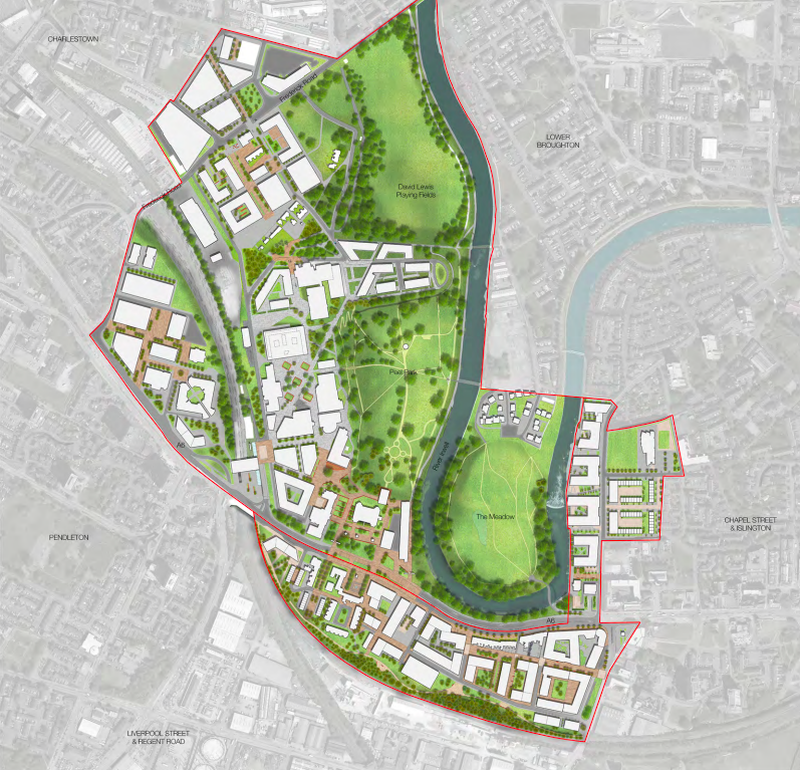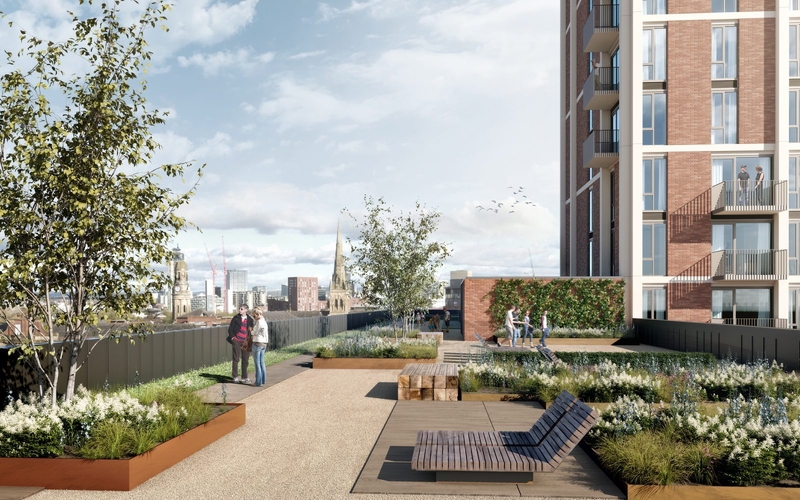Jonathan Schofield welcomes green ambition and thinking big next to the city centre
BIG PLANS are attractive, they stir the blood. The bells of development are ringing all over the central city region and this time they are tolling for the upper end of Chapel Street, The Crescent and around Salford University.
5plus Architects have dreamed dreams and conjured ideas of an integrated and highly attractive intro into the city centre via a throughfare of brave civic dimensions. This will be delivered through an enterprising liaison between those often awkward bedfellows, town and gown, in this case Salford City Council and Salford University.
We don’t want to leave this hugely significant area to piecemeal development
This is what the official release says: ‘The vision is to bring together five different development zones to create a new city district with a world class centre of learning, collaboration and industry at its heart surrounded by open green space and heritage.
‘The masterplan outlines a new innovation district with incubation space for business start-ups and SMEs; a new health village with GP services and expanded nursery provision; a range of new housing from family homes with gardens to a 30-storey tower and a new Civic and Cultural gateway celebrating the area’s culture and heritage assets.’
The bit that will appeal to most in the conurbation is ‘the radical improvement of the public realm with new walking and cycling routes connecting through the (Salford University) campus to the green assets of The Meadow and Peel Park and a new linear park running behind The Crescent along the route of the Manchester, Bolton and Bury canal.’

So let’s get in the time machine, give it a few years, and take a stroll from Manchester Cathedral. This passes monuments such as Sacred Trinity Church, the old Town Hall in Bexley Square, Salford Cathedral, St Philips Church and the old Royal Infirmary.
Chapel Street has nothing gap tooth about it on this stroll, with a building line from the junction with Oldfield Road all the way back into the city. Here are new apartments with good ground floor uses and plenty of opportunity to have a coffee, a pint or food.
At Adelphi, the long graceful curve of The Crescent stretches to our left, the lovely 200 year old properties now returned to townhouse living. To the right there are views across the magnificent meander of the River Irwell and the open area known as The Meadows to the Pennines. We now have a choice on a walk in the future, the high road or the low road.
Take the new footbridge down to the Meadows and then through the splendidly refurbished Peel Park and then up the grand staircase to Salford Art Gallery. It’s notable to the east of the Gallery that the dreary 1950s Maxwell Building has been refaced and improved while its bulk has been diminished, although did the new Conference Centre have to be placed here? Wouldn’t it have been better for Peel Park and the lawns bordering the Crescent to appear one seamless park with the only focus the Gallery?

As for the Gallery itself, let’s, during our imagined walk, hope that more of Salford’s good art collection is on display, aside from one meagre space in the 2018 building, and that the utterly confusing circulation has been sorted out. In fact, why not make Salford Art Gallery, The Museum of Manchester and Salford Life, showing how these cities have made huge national and international contributions to the world we live in, a little like the Museum of Liverpool with less spooned on sentiment.
Across the Crescent here are other monuments such as the superb Working Class Movement Library (WCML) and the old Fire Station. The plan here is to make this area a cracking food hub for the west of the city centre, something of a variant on Mackie Mayor perhaps.
There’s no time to walk up to Frederick Road and the large scale University changes taking place there, which are encouraging a real campus ethos, although it’s hoped William Mitchell’s crazy Minutemen sculptures, the very epitome of sixties street art, have found a safe home. In fact, let’s hope they join the party in this Gallery area, the cultural and creative heart of the new masterplan.

We now seek out more green space in an urban context and a return along the former line of the Manchester Bolton & Bury Canal. So after the WCML we turn left under a 30 storey residential tower, forming, with another on the west and the other side of the A6, a gateway into the city. We note how Salford Crescent Station has been improved.
We then turn south and east and come to a new ‘park’, but really more of a landscaped walkway, past proper town houses similar in scale to award-winning Timekeeper’s Square, a short trot away, and then more high density accommodation.
To get back into town we can cut through the Middlewood development walking alongside restored canal sections and then over the footbridge under the Ordsall Chord to The Factory in St John’s.
That’s been a walk of perhaps two miles and there has been so much to enjoy, so much to see, and so many places to live both literally and figuratively. That’s the dream.
Now it has to be delivered.
Shelagh McNerney, Head of Development at Salford, says: “The timing’s right we feel. We don’t want to leave this hugely significant area to piecemeal development and that’s why the masterplan is a partnership with the University. We think it’s stronger for being a joint plan with significant civic institutions working together.
“We’ve looked around at how places such as Ancoats have developed and we want to learn the lessons. How do we get the heritage assets back into use and allow them to give context and meaning to the location and the new buildings? We want to be on top of that.
“Above all we want to create a real sense of place, we want to become an area where people linger. At present there are few places to eat for example, and we want that to change.
"The area has not just the heritage assets but the river and the park and so much potential for providing superb public realm, and this will also encourage people to stick around. The University wants to concentrate on the creation of a campus and that ties in with us creating new residential areas for ‘grown-ups’, so to speak, and we want variety too, higher density towers along with proper town houses.”

McNerney and I agree on the value of the A6 - Chapel Street and The Crescent in other words. Unlike Rochdale Road in the Northern Gateway plans, this is a highway that can be traffic-calmed, but also gives the whole of 5plus Architect’s generally excellent masterplan real visibility and real viability. It is a key historical artery into the city centre, and especially at the point where it passes against the meander of the Irwell and close to Salford Art Gallery, should look splendid if these plans come to fruition.
Getting that footbridge over to the Meadows from The Crescent will be key however. The money is not in place at present. Section 106 payments from developers could perhaps be used, but why can’t this be a gift of philanthropy from an individual or a company? Sir Norman Stoller has recently provided around £10m for the Stoller Hall at Chetham’s School of Music and the new organ at Manchester Cathedral.
There has already been a competition for the bridge and a costing of half that amount. Surely someone in this region can put their hands in their deep pockets and provide a lasting monument to their generosity and also a permanent solution to the unlocking of the Meadows and Peel Park.
There is a consultation in the Old Fire Station on The Crescent (opp Salford Art Gallery) this Saturday from 10am-1pm. You can view the masterplan here.
For a Manchester Confidential article about The Meadows click here.















